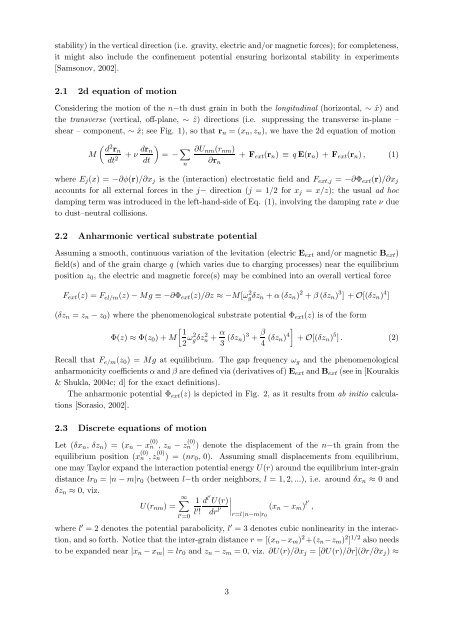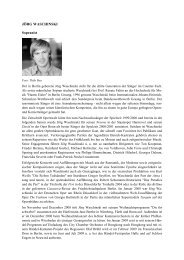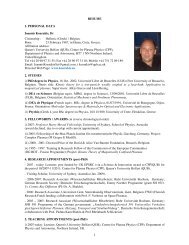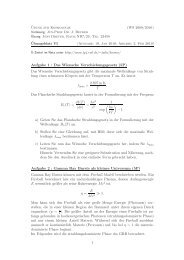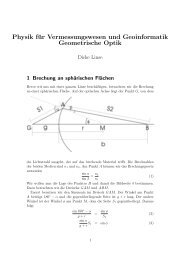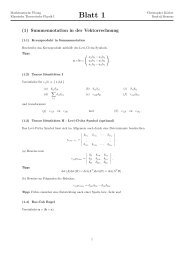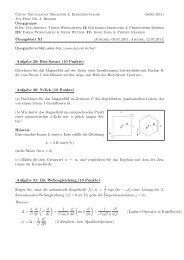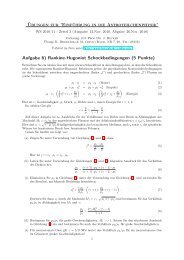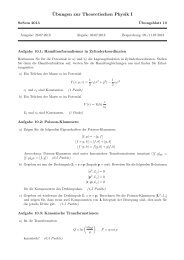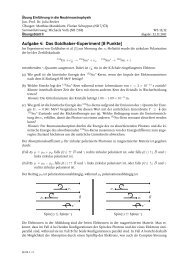View - Theoretische Physik IV - Ruhr-Universität Bochum
View - Theoretische Physik IV - Ruhr-Universität Bochum
View - Theoretische Physik IV - Ruhr-Universität Bochum
You also want an ePaper? Increase the reach of your titles
YUMPU automatically turns print PDFs into web optimized ePapers that Google loves.
stability) in the vertical direction (i.e. gravity, electric and/or magnetic forces); for completeness,<br />
it might also include the confinement potential ensuring horizontal stability in experiments<br />
[Samsonov, 2002].<br />
2.1 2d equation of motion<br />
Considering the motion of the n−th dust grain in both the longitudinal (horizontal, ∼ ˆx) and<br />
the transverse (vertical, off-plane, ∼ ẑ) directions (i.e. suppressing the transverse in-plane –<br />
shear – component, ∼ ˆx; see Fig. 1), so that r n = (x n ,z n ), we have the 2d equation of motion<br />
M<br />
( d 2 r n<br />
dt 2<br />
+ ν dr )<br />
n<br />
= − ∑ dt<br />
n<br />
∂U nm (r nm )<br />
∂r n<br />
+ F ext (r n ) ≡ q E(r n ) + F ext (r n ), (1)<br />
where E j (x) = −∂φ(r)/∂x j is the (interaction) electrostatic field and F ext,j = −∂Φ ext (r)/∂x j<br />
accounts for all external forces in the j− direction (j = 1/2 for x j = x/z); the usual ad hoc<br />
damping term was introduced in the left-hand-side of Eq. (1), involving the damping rate ν due<br />
to dust–neutral collisions.<br />
2.2 Anharmonic vertical substrate potential<br />
Assuming a smooth, continuous variation of the levitation (electric E ext and/or magnetic B ext )<br />
field(s) and of the grain charge q (which varies due to charging processes) near the equilibrium<br />
position z 0 , the electric and magnetic force(s) may be combined into an overall vertical force<br />
F ext (z) = F el/m (z) − Mg ≡ −∂Φ ext (z)/∂z ≈ −M[ω 2 gδz n + α(δz n ) 2 + β (δz n ) 3 ] + O[(δz n ) 4 ]<br />
(δz n = z n − z 0 ) where the phenomenological substrate potential Φ ext (z) is of the form<br />
[ 1<br />
Φ(z) ≈ Φ(z 0 ) + M<br />
2 ω2 g δz2 n + α 3 (δz n) 3 + β ]<br />
4 (δz n) 4 + O[(δz n ) 5 ]. (2)<br />
Recall that F e/m (z 0 ) = Mg at equilibrium. The gap frequency ω g and the phenomenological<br />
anharmonicity coefficients α and β are defined via (derivatives of) E ext and B ext (see in [Kourakis<br />
& Shukla, 2004c; d] for the exact definitions).<br />
The anharmonic potential Φ ext (z) is depicted in Fig. 2, as it results from ab initio calculations<br />
[Sorasio, 2002].<br />
2.3 Discrete equations of motion<br />
Let (δx n , δz n ) = (x n − x (0)<br />
n , z n − z n (0) ) denote the displacement of the n−th grain from the<br />
equilibrium position (x (0)<br />
n ,z n (0) ) = (nr 0 , 0). Assuming small displacements from equilibrium,<br />
one may Taylor expand the interaction potential energy U(r) around the equilibrium inter-grain<br />
distance lr 0 = |n − m|r 0 (between l−th order neighbors, l = 1,2,...), i.e. around δx n ≈ 0 and<br />
δz n ≈ 0, viz.<br />
U(r nm ) =<br />
∞∑<br />
l ′ =0<br />
∣<br />
1 d l′ U(r) ∣∣∣r=l<br />
l ′ (x n − x m ) l′ ,<br />
! dr l′ |n−m|r0<br />
where l ′ = 2 denotes the potential parabolicity, l ′ = 3 denotes cubic nonlinearity in the interaction,<br />
and so forth. Notice that the inter-grain distance r = [(x n −x m ) 2 +(z n −z m ) 2 ] 1/2 also needs<br />
to be expanded near |x n − x m | = lr 0 and z n − z m = 0, viz. ∂U(r)/∂x j = [∂U(r)/∂r](∂r/∂x j ) ≈<br />
3


